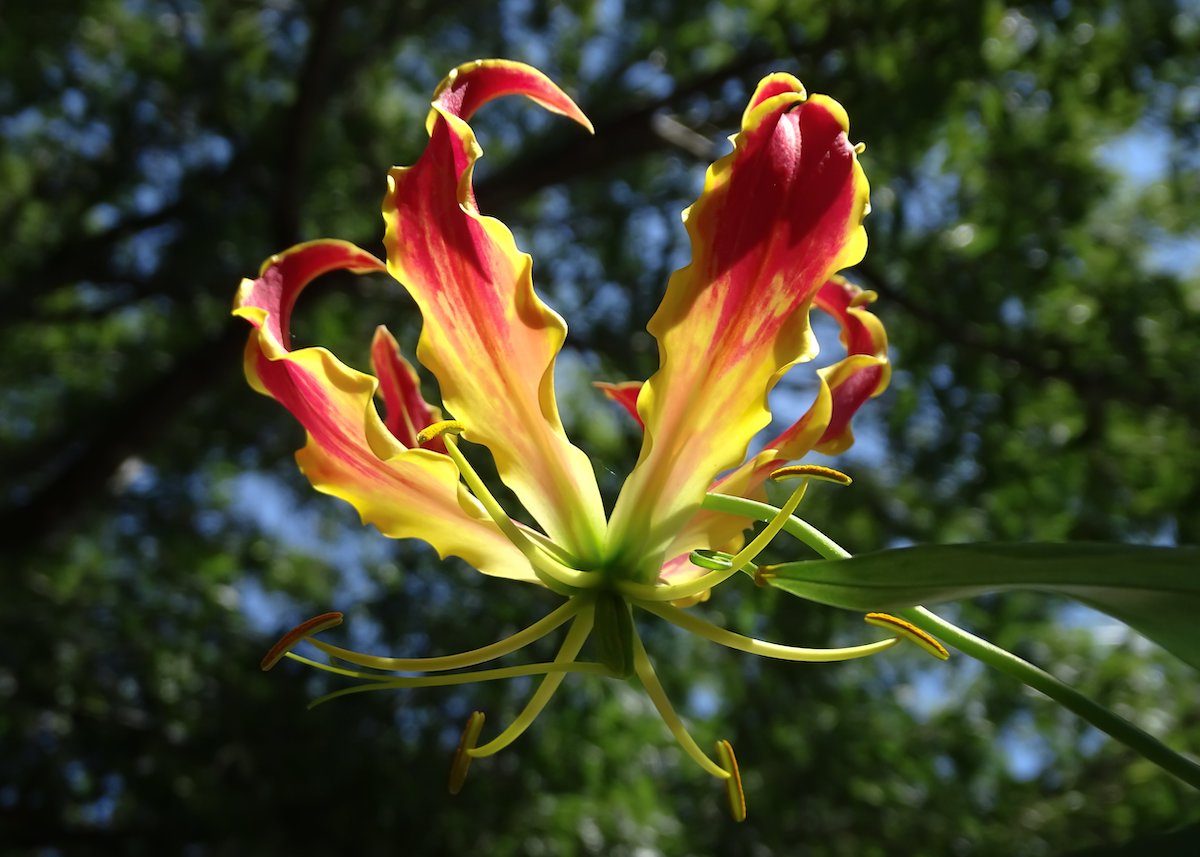Wondering if a gloriosa lily is a good plant for your garden? Get expert care tips, plus find out if these plants are poisonous or invasive.

Gloriosa Lily Care and Growing Tips

On This Page
How to Grow a Gloriosa Lily

“What is this lily-type flower?” asks Birds & Blooms reader Pat Given of Santa Fe, Texas.
Gardening expert Melinda Myers says, “This unique climber, Gloriosa superba, goes by the common names gloriosa lily, climbing lily, cat’s claw and several more. Hardy in Zones 8 and warmer, it’s grown as an annual, or the tubers can be dug out in fall and stored indoors for winter in colder regions. This plant prefers full or filtered sun and rich, well-draining soil. Mulch the soil to keep roots cool and moist as temperatures climb.
- Botanical name: Gloriosa superba or Gloriosa rothschildiana
- Common names: Gloriosa lily, fire lily, glory lily, or climbing lily
- Zones: 8 to 11, or annual
- Light needs: Full or partial shade
- Soil: moist, well-draining
- Size: 3 to 8 feet tall and 2 to 3 feet wide
- Attracts: bees, butterflies, and sometimes hummingbirds
Master gardener Tabar Gifford, partnership cultivator with American Meadows and High Country Gardens, says, “Gloriosa lily is a tropical trailing vine native to Africa that produces flame-colored blooms. (It’s) an eye-catching tender perennial that’s perfect for growing in a pot or in the garden—just make sure to give it something to climb on. They need a good support structure to really show off their beauty and thrive.”
She emphasizes that gloriosa lilies are happiest when they have a growing environment that matches their native climate. “They require warmth and humidity to flourish,” she says. “Regular deadheading will encourage more blooms, so taking the time to carefully remove and discard spent blooms is advantageous.”
What Does a Gloriosa Lily Look Like?

Once you see this plant in bloom, you’ll understand why some gardeners call it a fire lily. “The gloriosa lily has striking, exotic flowers with unusual rich-toned red flowers, penciled yellow edges and swept back petals, resembling flames,” says Tabar. “Its lance-shaped foliage grows on vining stems, and plants can reach 3 to 8 feet tall in a season.”
When to Plant a Gloriosa Lily

Melinda says gardeners should start tubers indoors for earlier flowering or plant them directly in the garden 2 to 4 inches deep after the last spring frost. Set the tubers horizontally in the ground, cover with soil, and water. Keep the soil moist throughout the growing season.
In cooler zones, tubers can be dug up and stored before freezing temperatures set in.
Where to Plant Gloriosa Lily
Tabar recommends you place them in a sunny location (six to eight hours of sun per day) with compost enriched, well-draining soil. Avoid intense afternoon sun if possible.
“Plant gloriosa lily 2 to 3 inches away from your trellis. Keep the soil evenly moist until shoots appear two to three weeks after planting, then reduce watering to once or twice per week, whenever it feels dry an inch below the surface,” she says. “Tie the vine as it begins to grow up the trellis, just to get them started. Fertilize regularly during the growing season and enjoy a summer filled with tropical flowers!”
Can You Grow Gloriosa Lily in Containers?
Lauren Carvalho, horticultural manager for High Country Gardens, says, “Yes, gloriosa lilies can be grown in containers. Just make sure they have well-draining soil and a warm, partially sunny spot.”
Tabar adds, “Their vertical growth makes them ideal for small gardens or containers, saving ground space while adding height and visual interest.”
Are Gloriosa Lilies Poisonous?
It’s important to note that all parts of this plant are poisonous, so take care when growing around kids and pets, including dogs, cats and horses.
Lauren says, “All parts of the gloriosa lily are toxic to animals and humans if ingested. The toxic alkaloid, colchicine, is concentrated in the tubers but taking extra precaution while handling will avoid potential irritations.” Wear gardening gloves and wash your hands thoroughly after working around these plants.
Are Gloriosa Lilies Invasive?
It’s considered invasive in some parts of the U.S. and a noxious weed in Australia. Consult your local extension agent if you have concerns about adding this plant to your garden. You can grow it in a container to keep it from spreading.
About the Experts
Melinda Myers is the official gardening expert for Birds & Blooms. She is a TV/radio host, author and columnist who has written more than 20 gardening books. Melinda earned a master’s degree in horticulture from the University of Wisconsin-Madison.
Lauren Carvalho is the horticultural manager for High Country Gardens. She grew up the daughter of a landscape designer, and working with plants has become the focus of Lauren’s adulthood and career. Beginning as an organic produce farmer in the Southwest, she developed a fascination with reducing the use of pesticides through using beneficial insects. This led to a life-altering opportunity learning to propagate native and pollinator-friendly, habitat-providing plants under the tutelage of horticulturalist David Salman. Currently, Lauren is working with some of the brightest thought leaders in western horticulture to learn about and tell the story of these incredibly important ecologically restorative and beautiful plants.
Tabar Gifford is the customer experience and partnership cultivator at American Meadows and High Country Gardens. Tabar a master gardener, and dedicated “plant geek,” passionately fosters connections. With a lifelong love for gardening and nature, and a bachelor’s degree in environmental studies from the University of Vermont, she combines horticultural expertise with a commitment to education.




















